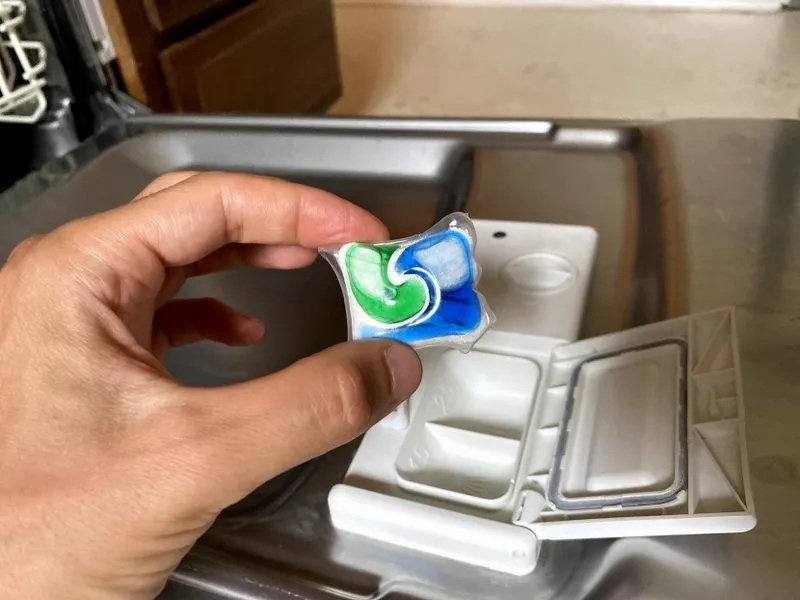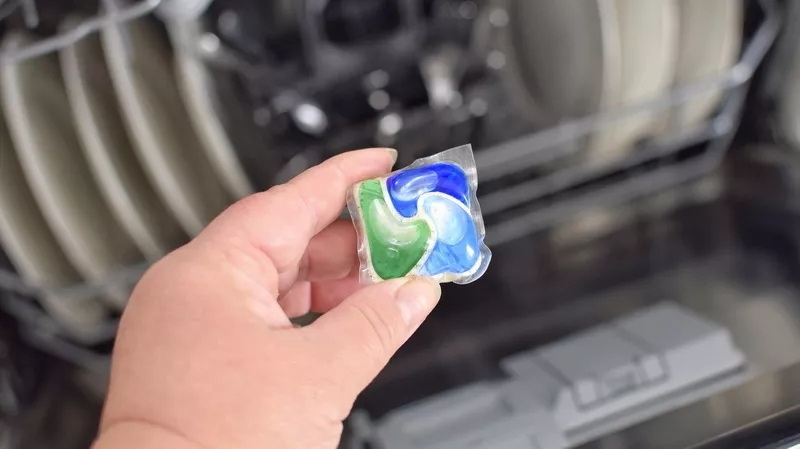Dongguan UFine Daily Chemical Co.,Ltd.
- All
- Product Name
- Product Keyword
- Product Model
- Product Summary
- Product Description
- Multi Field Search
Views: 222 Author: Tomorrow Publish Time: 11-20-2025 Origin: Site











Content Menu
● What Is Nylon and Why Is It Popular?
● The Role of Film Materials in Dishwasher Pods
● Can Nylon Be Used to Make Dishwasher Pods?
● Comparing Nylon and PVA Film
● The Science Behind Soluble Pod Films
● Dishwasher Pod Manufacturing and Materials
● Environmental and Safety Considerations
● Common Misconceptions About Nylon Pods
● Alternatives to Nylon in Pod Production
● Proper Use and Handling of Dishwasher Pods
● Future Innovations in Pod Films
● FAQ
>> 1. Why isn't nylon used for dishwasher pods?
>> 2. What material is typically used in dishwasher pods?
>> 3. Can nylon be modified to become water-soluble?
>> 5. What eco-friendly alternatives exist to PVA films?
Dishwasher pods have become essential in modern kitchens for their convenience, precise measurement, and effective cleaning performance. Many curious home experimenters and small manufacturers wonder whether nylon can be used when producing or packaging dishwasher pods. Although nylon is widely used in textiles, packaging, and plastics, using it directly in dishwasher pod production requires a more in-depth understanding of chemical compatibility, safety, and functionality.
This article explores whether nylon is suitable for making dishwasher pods, covering its chemical properties, use cases, and viable alternatives. It aims to clarify misconceptions and guide readers toward the right materials for safe and efficient dishwasher cleaning products.

Nylon is a synthetic polymer derived from petrochemicals. It is known for high strength, flexibility, abrasion resistance, and durability. Its chemical name is polyamide, represented by long repeating chains of amide bonds. These bonds give nylon stability and resistance to wear, making it ideal for industrial and consumer goods.
Nylon's key advantages include:
- High mechanical strength and flexibility.
- Resistance to oil, grease, and many cleaning agents.
- Thermal stability up to moderate heat levels.
- Affordable manufacturing and easy molding.
Due to these benefits, nylon is often used in clothing fibers, packaging films, automotive parts, and even filter meshes. However, not all properties that make nylon useful in daily life translate well when exposed to dishwasher environments or detergent chemical reactions.
Dishwasher pods or capsules are compact units that contain detergent, rinse aid, and sometimes degreasing agents. These small packets rely heavily on their film material because it determines how and when the detergent dissolves.
The most common film used in dishwasher pods is polyvinyl alcohol (PVA). PVA is water-soluble, non-toxic, and biodegradable under proper conditions. Once a pod is placed in the dishwasher, the PVA film quickly dissolves in water, releasing detergent into the cleaning cycle.
The film plays three main roles:
1. Protection: It seals the liquid or powder inside, preventing moisture absorption.
2. Controlled release: It ensures that detergent dissolves at the correct time.
3. Safety: It reduces direct human contact with concentrated cleaning agents.
Any material chosen for pods must meet food safety and environmental standards and also dissolve efficiently without residue.
Strictly speaking, nylon is not suitable for making dishwasher pods. This is primarily because nylon is not water-soluble, which means it will not dissolve in the dishwasher cycle. Dishwasher pods must dissolve completely in both hot and cold water to release detergent at the correct moment. Nylon's resistance to water prevents this process and can lead to cleaning issues or blockages.
Here are some scientific and practical reasons nylon cannot replace PVA:
- Water Insolubility: Nylon resists water absorption and does not break down quickly in aqueous environments.
- Heat Resistance: Although nylon can withstand high temperatures, it does not melt or dissolve easily in hot water, unlike PVA films.
- Residual Waste: Nylon film would remain intact after a wash cycle, leaving plastic residue inside dishes or filters.
- Chemical Reaction Risk: Dishwasher detergents contain enzymes and alkaline ingredients that could degrade nylon over time, releasing undesirable residues.
Therefore, while nylon has many industrial uses, it fails the key performance criteria required for dissolvable pod film material.
The following comparison table summarizes the major differences between nylon and PVA film materials in dishwasher pod applications:
| Property | Nylon (Polyamide) | PVA (Polyvinyl Alcohol) |
|---|---|---|
| Solubility in Water | Not soluble | Fully soluble |
| Biodegradability | Poor | Good |
| Dishwasher Safety | Not suitable | Well-suited and safe |
| Chemical Compatibility | Moderately resistant | Compatible with detergents |
| Environmental Impact | Non-degradable plastic waste | Biodegradable under correct conditions |
| Texture and Transparency | Tough, flexible, clear | Thin, smooth, transparent |
This table highlights that while nylon provides excellent durability, it lacks the key property of solubility essential for dishwasher pods. PVA, on the other hand, is engineered precisely for this function.

Dishwasher pods rely on polymer films that dissolve completely upon contact with water. The film must remain stable in storage but rapidly disintegrate during use. The solubility rate depends on temperature, pH, and polymer composition.
PVA films are hydrophilic, meaning they attract and interact with water molecules, causing molecular chains to loosen and dissolve. Manufacturers can adjust PVA's molecular weight to control dissolving speed for specific dishwasher conditions.
Nylon, being a hydrophobic polymer, repels water and maintains strong intermolecular hydrogen bonds. This makes it stable in water but unsuitable for dissolving. Even if treated with additives to improve solubility, nylon's inherent chemical structure resists breaking apart efficiently.
The manufacturing process of dishwasher pods involves creating a film stable enough for shipping and handling but that dissolves in water during the wash cycle. According to recent industry insights, polyvinyl alcohol (PVA) is the film of choice across major detergent brands due to its water-soluble and biodegradable nature. Manufacturers use automated rollers with molds to shape pods, enclosing powdered or liquid detergent in PVA films that dissolve effectively upon contact with water.
Alternative materials are still under development, but PVA remains the standard because of its safety profile and performance in both cold and hot water environments. Nylon or other non-water soluble plastics are not used because they fail to dissolve, causing residue and environmental concerns.
With increasing consumer awareness about plastic pollution and microplastics, the choice of pod film is crucial in mitigating environmental impact. Nylon, being non-biodegradable and water-insoluble, can add to microplastic burdens if improperly discarded.
PVA films biodegrade under wastewater treatment conditions, reducing environmental harm. Safety-wise, the complete dissolution of PVA minimizes residues that can harm dishwashers, pipes, or food surfaces. Nylon fragments left behind would pose health risks and mechanical damage.
Some home DIY guides recommend using nylon mesh or fabric to hold detergent powders as pods. This is misguided because:
- Nylon meshes do not dissolve and leave waste residues.
- The cleaning agent release becomes inconsistent, reducing cleaning efficiency.
- Nylon may degrade unevenly under dishwashing conditions, releasing unwanted chemicals.
Overall, nylon meshes or films are unsuitable materials for dishwasher insert applications.
Besides PVA, other experimental materials include:
- Polyethylene oxide (PEO): Water-soluble and flexible but less common.
- Starch-based films: Fully biodegradable, derived from natural sources.
- Gelatin-based films: Biodegradable but sensitive to humidity.
These options focus on enhanced environmental friendliness while maintaining dissolution performance.
For best performance, dishwasher pods must be stored in dry, cool environments to avoid premature film breakdown. Films made with PVA require moisture-proof packaging, which is typically done using non-nylon materials to prevent water exposure. Consumers should follow manufacturers' instructions closely to ensure pods dissolve fully and work efficiently.
The detergent industry is advancing toward hybrid films combining synthetic and natural polymers to boost biodegradability without sacrificing stability. Research on enzymatically degradable films and microbial recycling polymers is ongoing to create fully eco-safe dishwasher pods beyond current PVA standards.
In conclusion, using nylon to make dishwasher pods is not feasible nor advisable due to nylon's lack of water solubility, persistence after washing, poor biodegradability, and potential safety hazards. Polyvinyl alcohol (PVA) remains the leading film material because it dissolves quickly and completely under dishwasher conditions, ensuring detergent release, environmental safety, and user convenience.
Manufacturers and DIYers should avoid nylon or similar non-dissolvable plastics and instead rely on tested polymers like PVA or emerging biodegradable alternatives to produce effective, safe, and environmentally responsible dishwasher pods.

Nylon does not dissolve in water and can leave residues in dishwashers. Dishwasher pods need water-soluble films that completely release detergent during wash cycles, which nylon cannot do.
Most dishwasher pods use polyvinyl alcohol (PVA) films. PVA is water-soluble, biodegradable, and compatible with detergents.
While certain chemical treatments can make nylon partly soluble, it is not economical or safe for dishwasher applications, as the film may still not dissolve fully.
No, nylon is a synthetic plastic that resists biodegradation. It can persist in the environment for decades, contributing to microplastic pollution.
Emerging alternatives include starch-based, cellulose-based, and polyethylene oxide (PEO) films. These provide varying degrees of biodegradability and solubility.
[1](https://www.polymersolutions.com/dishwasher-pods-how-do-they-work/)
[2](https://www.reddit.com/r/manufacturing/comments/1l76cbz/dishwasher_pods/)
[3](https://making.com/dishwasher-tablets)
[4](https://cen.acs.org/business/consumer-products/What-makes-dissolving-detergent-pods-hold-together-safe-environment/100/web/2022/07)
[5](https://www.reddit.com/r/YouShouldKnow/comments/xz57uz/ysk_dishwasher_pods_contain_pva_a_type_of_plastic/)
[6](https://www.homemadesimple.com/kitchen/whats-the-film-around-detergent-pods/)
[7](https://www.ufinechem.com/how-to-make-your-own-dishwasher-pods.html)
[8](https://www.youtube.com/watch?v=ItJ-_CbdPMQ)
[9](https://www.facebook.com/groups/951126225499216/posts/1599808533964312/)
[10](https://www.imarcgroup.com/dishwasher-pod-manufacturing-plant-project-report)